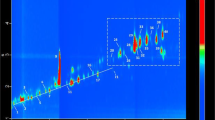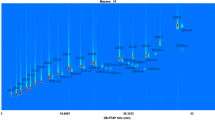Abstract
The present investigation is focused on the development of a comprehensive two-dimensional GC (GC × GC) method, with dual MS/FID detection, for the qualitative and quantitative analysis of the entire unsaponifiable fraction of vegetable oils. The unsaponifiable fraction forms a minor, highly specific part of a vegetable oil, and can be used as an indicator of genuineness. The column set used consisted of a low-polarity first dimension, and a medium-polarity secondary one, both characterized by a high thermal stability. The use of dual detection enabled the attainment of both mass spectral information and relative % FID data. The complexity of the fingerprint, generated by the unsaponifiable fraction, fully justified the employment of the two-dimensional GC technology. Furthermore, two other GC × GC benefits contributed greatly to the attainment of promising results, namely sensitivity enhancement and the formation of group-type patterns. The method herein proposed could potentially open a new opportunity for the more in-depth knowledge of the unsaponifiable fraction of vegetable oils.







Similar content being viewed by others
References
Christie WW (2003) Lipid analysis. The Oily Press, Bridgwater, England
Beltrán G, del Rio C, Sánchez S, Martínez L (2004) J Agric Food Chem 52:3434–3440
Ollivier D, Artaud J, Pinatel C, Durbec JP, Guérère M (2003) J Agric Food Chem 51:5723–5731
D’Imperio M, Dugo G, Alfa M, Mannina L, Segre AL (2007) Food Chem 102:956–965
Tranchida PQ, Giannino A, Mondello M, Sciarrone D, Dugo P, Dugo G, Mondello L (2008) J Sep Sci 31:1797–1802
Belitz H-D, Grosch W, Schieberle P (2004) Food chemistry. Springer, Berlin, pp 224–244
Dutta PC (ed) (2004) Phytosterols as functional food components and nutraceuticals. Dekker, New York
Cercasi L, Rodriguez-Estrada MT, Lerker G (2003) J Chromatogr A 985:211–220
Cunha SS, Fernandes JO, Oliveira MBPP (2006) J Chromatogr A 1128:220–227
Regulation 2568/91 and modifications, European Commission, 11th July 1991
Liu Z, Phillips JB (1991) J Chromatogr Sci 29:227–231
Cortes HJ, Winniford B, Luong J, Pursch M (2009) J Sep Sci 32:883–904
de Geus H-J, Aidos I, de Boer J, Luten JB, Brinkman UAT (2001) J Chromatogr A 910:95–103
Xu X, Gao Y, Sun L (2012) Food Res Int 48:650–656
Wang Z, Guhling O, Yao R, Li F, Yeats TH, Rose JKC, Jetter R (2011) Plant Physiol 155:540–552
Fiselier K, Grob K (2009) Eur Food Res Technol 229:679–688
Rupérez FJ, Martíin D, Herrera E, Barbas C (2001) J Chromatogr A 935:45–69
Dutta PC, Savage GP (2002) In: Guardiola F, Dutta PC, Codony R, Savage GP (eds) Cholesterol and phytosterol oxidation products: analysis, occurrence, and biological effects. AOCS, USA, p 322
Angerosa F, Campestre C, Giansante L (2006) In: Boskou D (ed) Olive oil: chemistry and technology, 2nd edn. AOCS, USA, pp 113–172
Rivera del Álamo RM, Fregapane G, Aranda F, Gómez-Alonso S, Salvador MD (2004) Food Chem 84:533–537
Acknowledgments
The Project was funded by the “Italian Ministry for the University and Research (MIUR)” within the PRIN Project n. 20098Y822 “Determination of biologically active molecules in natural matrixes using advanced chromatographic techniques”.
Author information
Authors and Affiliations
Corresponding author
Additional information
Published in the topical collection Nutraceuticals and Separations with guest editor Luigi Mondello.
Rights and permissions
About this article
Cite this article
Tranchida, P.Q., Salivo, S., Franchina, F.A. et al. Qualitative and quantitative analysis of the unsaponifiable fraction of vegetable oils by using comprehensive 2D GC with dual MS/FID detection. Anal Bioanal Chem 405, 4655–4663 (2013). https://doi.org/10.1007/s00216-013-6704-9
Received:
Revised:
Accepted:
Published:
Issue Date:
DOI: https://doi.org/10.1007/s00216-013-6704-9




